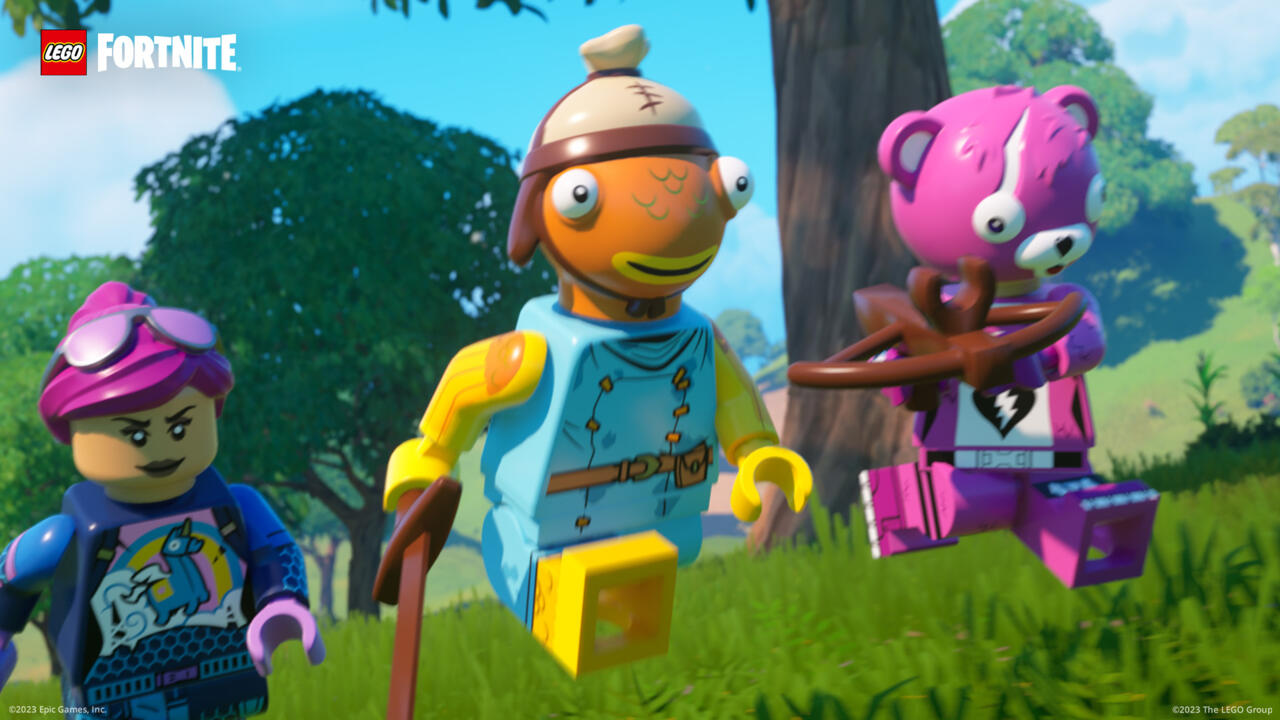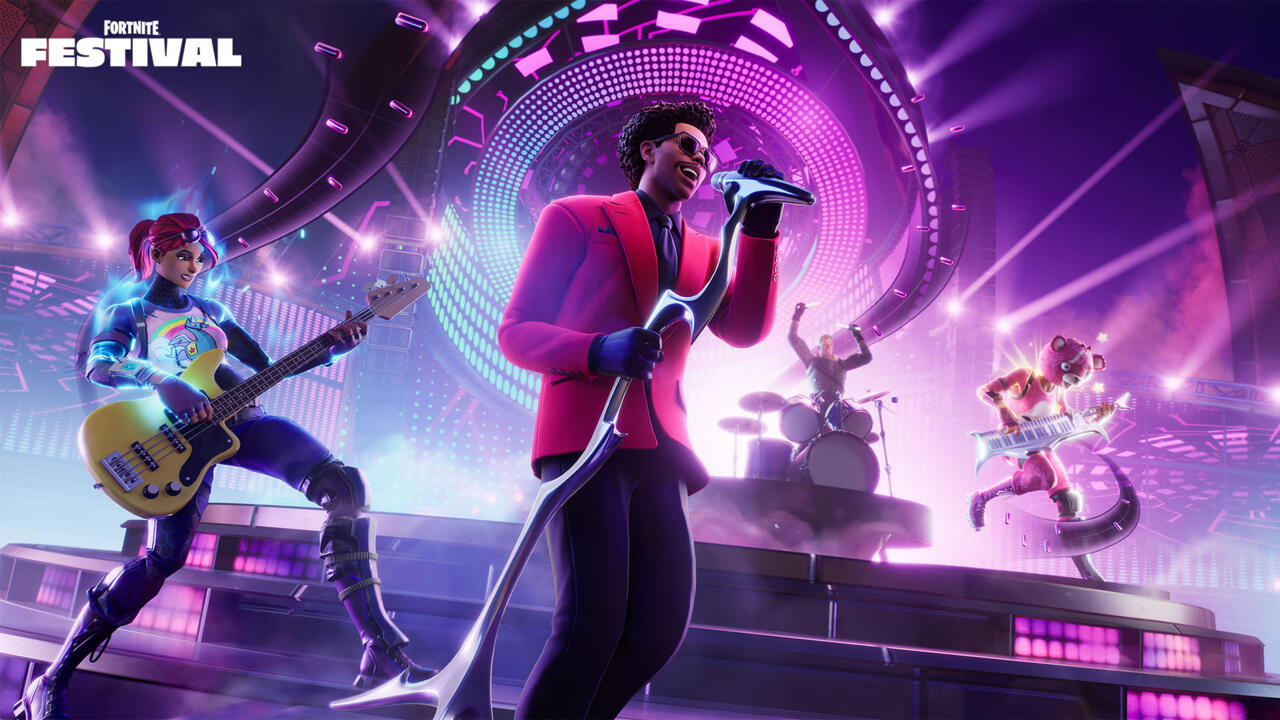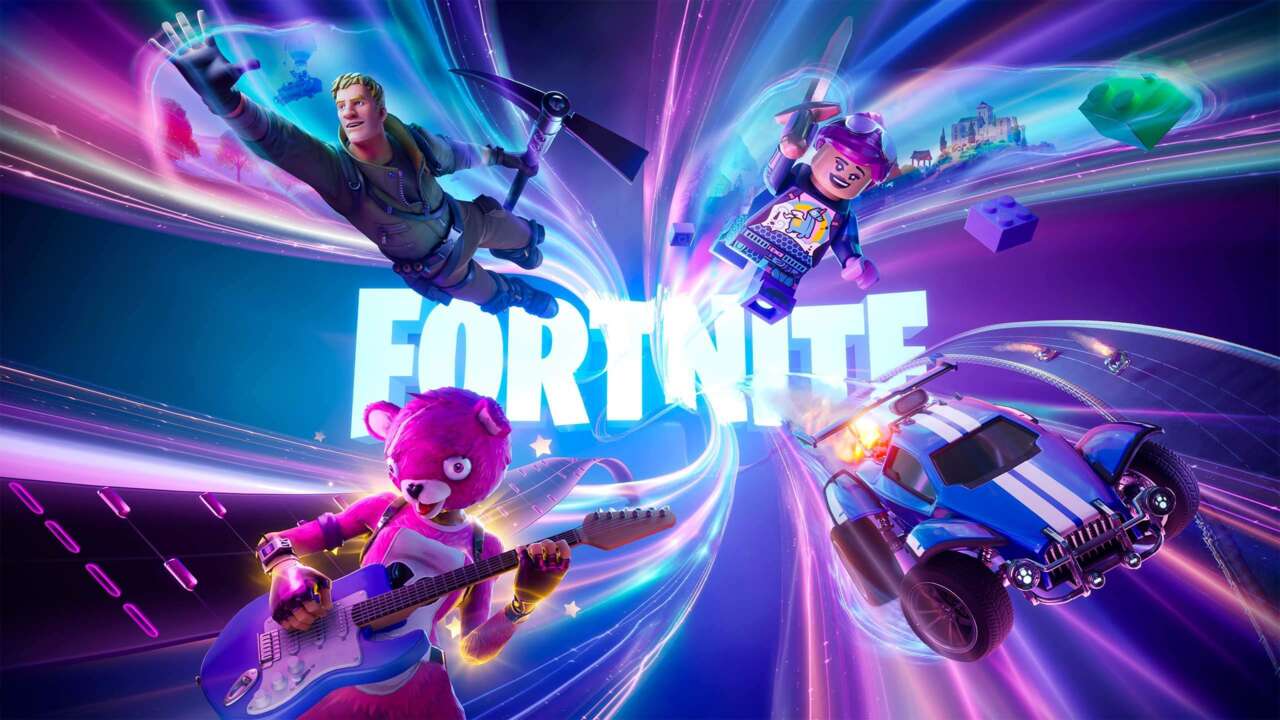Epic Won’t Call This Fortnite 2, But It Feels That Way To Me
Ask someone who doesn’t play Fortnite what they know about the game and they’re likely to mention a few things. There are all the funny emotes; no doubt they know that part. It’s got that dancing banana fella–he’s pretty cool. They’ll probably also call it a shooting game or, if they know the term, they’ll call it a battle royale game. It’s true that for six years, battle royale has been the centerpiece to Fortnite, but in that time, it’s also grown as a platform, with 70% of Fortnite players now also routinely playing in Creative mode, the game’s user-generated content sandbox with an ever-growing number and breadth of experiences.
But for anyone who didn’t yet know Fortnite was already more than a battle royale game, this week’s huge update, complete with three new games, beloved IP, and well-established studios, feels like a statement. Fortnite is changing, but its reign atop the video game world seems secure.
Lego Fortnite, Rocket Racing, and Fortnite Festival come from Epic, Psyonix, and Harmonix, respectively, and they exist as new games found exclusively within Fortnite. After playing them myself at a press event ahead of their staggered launch dates this week, I’ve trained myself to not call them “modes,” as any one of them would make sense as a standalone game. It’s sometimes been the case where a game on another maker-game platform like Roblox gets so popular that an outside studio acquires it in a buyout. These new Fortnite releases are sort of the inverse of that. Brilliant studios have been tasked with building new games with the explicit purpose of expanding Fortnite’s ecosystem.
Rocket Racing
I played Rocket Racing first, which exists in a universe meant to blend both Fortnite and Rocket League. The logo shares a font with the latter, but as you drift around corners to gain boost and launch yourself toward the ceilings of some tunnels by driving on the wall, you’ll spot plenty of Fortnite imagery, too, such as the iconic llamas carved into burnt-orange canyons. Rocket Racing is an arcade racer that doesn’t stray too far from the enjoyable tropes of the genre. While I didn’t see power-ups on any of the five tracks I raced, I saw speed boosters, ramps, hidden pathways, and a surprisingly (and satisfyingly) high skill ceiling.
The game’s boost system uses a secondary charge that’s activated a moment after the initial activation. This adds a subtle but appreciable layer to choosing when to use it, because not only do you need to get that timing just right, but the more intricate maps don’t seem to have a lot of straightaways, meaning you may want to more strongly consider when–or if–to burn through your boost, since you’re liable to send yourself speeding into a guardrail in some cases when you do.
Gallery
Similarly, cars can all jump just like they do in Rocket League, and those jumps can be made longer with a longer hold of the jump button. However, soaring off a ramp and taking flight for too long could slow you down and open a window for those below you to speed ahead on the road. To counter that, you can quickly leap down (or up, left, or right) to get your wheels on solid ground.
Quickly it became apparent that there’s going to be a best way to race each track, and though the most competitive players will look to shave off milliseconds in the game’s ranked mode, it also works as a family-friendly racing game thanks to the mechanics that, like Rocket League, can be hard to truly master but have an invitingly low barrier of entry. Because this is an Epic and Psyonix collaboration, you’ll also unlock cars for Rocket League when you gain them in Fortnite, and sometimes vice versa. And for players who might soon master the many tracks there on day one, Rocket Racing will work with Creative, allowing for user-created racetracks in the future.
Lego Fortnite
Later in the day, I played Lego Fortnite, which I’d call the odds-on favorite to become the most popular game of the three. Lego Fortnite is a survival-crafting game akin to Minecraft and the many games it’s inspired in the decade-plus since it became a phenomenon. But like Rocket Racing, Lego Fortnite benefits from having a foot in both worlds: Fortnite and Lego. The game looks stunning thanks to Unreal Engine 5, and the procedurally generated worlds are 20 times bigger than the Fortnite battle royale island–and I was told this size may well continue to grow as time goes on.
But the added layer of Lego charm makes it an appealing timesink. A tutorialized intro in which a minifig version of Cuddle Team Leader talks you through the typical opening moments of a survival-crafting game–building a bed, an axe, a small shelter, and so on–make it a much more understandable experience for younger players, but your pink bear friend is also almost fully ignorable, so if you want to learn everything for yourself through exploring and experimenting, you can. To the delight of Lego purists, some builds also require multiple steps, like building a real Lego set on your table. To create my modest shack, I had to build each wall, then a floor, and then a roof, placing them according to in-game instructions. These are done as big chunks, not brick-by-brick, though freeform brick pieces appeared in my crafting book a short time later.

Gallery
New builds, recipes, and items unlocked early and often, but it never felt overwhelming because I had a strong sense of what I needed to collect or build in order to progress. That’s something that a lot of games like this get wrong– perhaps on purpose to preserve some mystery, but it can be really punishing for players not used to the genre. I tried to picture my kids getting to grips with Lego Fortnite’s systems. My Minecraft expert of a son will find Lego Fortnite easy to grasp, no doubt, and although my daughter will need help while she’s too young to read, she plays enough games that I think the clear UI signposting of what she lacks for a recipe will be enough to send her out in search of whatever it may be after some initial help from me or my wife. And if ever either of them don’t want to worry about the game’s survival systems, a more forgiving sandbox mode removes the resource scarcity and enemy threats and just lets them build and explore.
Lego Fortnite can be played in parties of up to eight people, and the game launches on the heels of a content ratings overhaul that is meant to allow parents to fine-tune their children’s experiences in Fortnite, both in terms of what they can play and with whom they can play it. I asked Epic executive vice president Saxs Persson about these options, knowing Roblox, one of Fortnite’s rivals, has previously come under scrutiny for dropping the proverbial ball with regard to keeping mature content out of younger players’ hands because it can be good for business. Though he gave me lots of specifics of how Fortnite’s new ratings system (and legacy parental controls) work, the most assuring part of what he said was that The Lego Group wouldn’t have it any other way.
“Lego would never stand for that,” Persson told me, speaking to the idea that Fortnite’s ratings system could be tuned to allow inappropriate but lucrative games to make it in front of the wrong audiences. “Surely we have a shared interest with Lego in making a system we believe is transparent and actually services what parents would expect. Trust for us is pivotal. [The Lego Group has] been with us every step of the way as we’ve crafted the experience of, ‘How do you do voice chat that’s both what players expect, but also safe and controllable from a parent’s perspective?’ ‘How do we do ratings in a way that parents feel in control of what their kids are playing, and they get to not feel like they either open the floodgates fully, or they close them off?’ You have to be really diligent about that. It’s taken the better part of the last two years.”
Like Rocket Racing, players also get looped into the Fortnite ecosystem when they play Lego Fortnite, not just because it’s found within the platform, but also because over 1,200 Fortnite skins have been converted into Lego form, which Persson told me the team crafted individually–and will continue crafting over time.
Included in these plans is the process of turning some of Fortnite’s licensed characters into Lego minifigs, with some surprises in store, too. “There’s plenty of characters in the works that’ve never had a Lego minifig before [and now] we’re making the first Lego minifig for that IP,” Persson said. “I’ve found everybody extremely receptive[…]I’d be surprised if the majority of IPs don’t make it in at some point.”
Fortnite Festival
Though I plan to sink lots of time into all three games, Fortnite Festival feels like my favorite of them right now. It is, in essence, a revival of Rock Band, but once more not without some touches that Fortnite allows. Fortnite Festival is played in groups of up to four players, and each one picks from lead guitar, bass, drums, or vocals–though no actual singing is involved. Your band starts backstage and creates a playlist together, then hits the stage to perform a chosen number of a few dozen licensed tracks that are there at launch–with more coming often, I was told.
Full songs play out very much like you’d remember from the days of Guitar Hero and Rock Band–save for the lack of actual vocalizing–and considering it comes from Harmonix, you can expect the same well-tuned difficulty options that suit all skill levels. I was never very good at Rock Band or games like it, but I always had a blast anyway because I simply love gamifying music in the way those games do, so it was immediately great to play something so similar to those again.

Gallery
The game’s launch-day tracklist includes an eclectic mix of current and past bangers from Queens of the Stone Age, Billie Eilish, Weezer, and more. There’s also going to be an Icon in the spotlight each season, with the game’s first being The Weeknd, who also comes to the game as a skin for sale with multiple style options. That means several of his songs are available today, with future Icons getting similar song–and sometimes skin–treatment.
But the unique Fortnite touch added to the experience actually happens in a separate mode of Fortnite Festival. Whereas you’ll play full songs on the main stage, you can also create jam sessions in a space akin to Fortnite’s Party Royale. You load out with up to eight jam tracks of your choosing accessed via your emote wheel, and you then play different sections of a song as you see fit. When up to three others come into the inner ring of your circle shown on screen, they can join in the track, and if others want to spectate the jam session, they need only to enter the outer ring of that circle, allowing them to hear you play.
Like Harmonix’s Fuser and DropMix, the end result is a multiplayer musical mash-up that, in Fortnite, works best as a social hangout space. I may be playing the bassline from Seven Nation Army while someone else is playing the drums from Blinding Lights, another is playing the vocals from Bad Guy, and another is on lead guitar from Go With The Flow, and all the while we may just be chatting about our week or talking about the GTA 6 trailer, or whatever else may be on our minds. While this feature is secondary to the game’s main attraction of being a pure Rock Band revival, these same jamming-via-emotes tools are also now in battle royale, which can make a heck of a display during the Victory Royale screen.
The most surprising aspect of all of these new games coming to Fortnite this week is that their simultaneous launches were not always the plan. “If you had asked a year ago if this is how it was gonna play out, none of us would’ve thought so,” Persson told me, saying the vision for the three-pronged launch started to come together only earlier this year, in March. “We started toying with the idea of a Big Bang to reset the ecosystem back during GDC, when we launched [UEFN]. And then toward the fall, it looked like two out of three would hit [the launch window].”
He continued, “The idea that they all co-launched–you can’t really afford to tell yourself all that development lines up like that, like that’s just not game development.” However, by the fall, all three would wind up ready for the new chapter launch–something Epic has made a major annual event every December for three years now–and when that happened, Persson said the feeling within Epic was, “Well, we’re all in now.”
Lego Fortnite, Rocket Racing, and Fortnite Festival are all now available for free within Fortnite. Playing any of the games rewards battle pass XP and includes other game-specific rewards. Their individual seasons will also run at their own paces and aren’t necessarily bound by the Fortnite battle royale season structure.
The products discussed here were independently chosen by our editors.
GameSpot may get a share of the revenue if you buy anything featured on our site.
Check out our Latest News and Follow us at Facebook
Original Source







